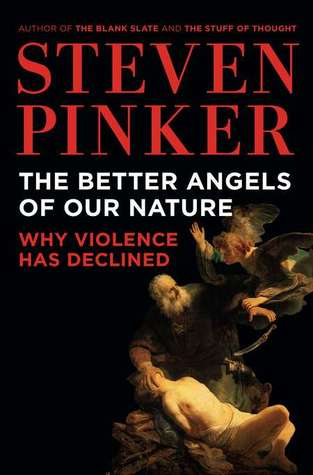Means of Quantifying Violence
Now let’s turn to the present. According to the most recent edition of the Statistical Abstract of the United States, 2,448,017 Americans died in 2005. It was one of the country’s worst years for war deaths in decades, with the armed forces embroiled in conflicts in Iraq and Afghanistan. Together the two wars killed 945 Americans, amounting to 0.0004 (four-hundredths of a percent) of American deaths that year.57 Even if we throw in the 18,124 domestic homicides, the total rate of violent death adds up to 0.008, or eight-tenths of a percentage point. In other Western countries, the rates were even lower. And in the world as a whole, the Human Security Report Project counted 17,400 deaths that year that were directly caused by political violence (war, terrorism, genocide, and killings by warlords and militias), for a rate of 0.0003 (three-hundredths of a percent).58 It’s a conservative estimate, comprising only identifiable deaths, but even if we generously multiplied it by twenty to estimate undocumented battle deaths and indirect deaths from famine and disease, it would not reach the 1 percent mark.
The major cleft in the graph, then, separates the anarchical bands and tribes from the governed states. But we have been comparing a motley collection of archaeological digs, ethnographic tallies, and modern estimates, some of them calculated on the proverbial back of an envelope. Is there some way to juxtapose two datasets directly, one from hunter-gatherers, the other from settled civilizations, matching the people, era, and methods as closely as possible? The economists Richard Steckel and John Wallis recently looked at data on nine hundred skeletons of Native Americans, distributed from southern Canada to South America, all of whom died before the arrival of Columbus.59 They divided the skeletons into hunter-gatherers and city dwellers, the latter from the civilizations in the Andes and Mesoamerica such as the Incas, Aztecs, and Mayans. The proportion of hunter-gatherers that showed signs of violent trauma was 13.4 percent, which is close to the average for the hunter-gatherers in figure 2–2. The proportion of city dwellers that showed signs of violent trauma was 2.7 percent, which is close to the figures for state societies before the present century. So holding many factors constant, we find that living in a civilization reduces one’s chances of being a victim of violence fivefold.
Let’s turn to the second way of quantifying violence, in which the rate of killing is calculated as a proportion of living people rather than dead ones. This statistic is harder to compute from boneyards but easier to compute from most other sources, because it requires only a body count and a population size, not an inventory of deaths from other sources. The number of deaths per 100,000 people per year is the standard measure of homicide rates, and I will use it as the yardstick of violence throughout the book. To get a feel for what these numbers mean, keep in mind that the safest place in human history, Western Europe at the turn of the 21st century, has a homicide rate in the neighborhood of 1 per 100,000 per year.60 Even the gentlest society will have the occasional young man who gets carried away in a barroom brawl or an old woman who puts arsenic in her husband’s tea, so that is pretty much as low as homicide rates ever go. Among modern Western countries, the United States lies at the dangerous end of the range. In the worst years of the 1970s and 1980s, it had a homicide rate of around 10 per 100,000, and its notoriously violent cities, like Detroit, had a rate of around 45 per 100,000.61 If you were living in a society with a homicide rate in that range, you would notice the danger in everyday life, and as the rate climbed to 100 per 100,000, the violence would start to affect you personally: assuming you have a hundred relatives, friends, and close acquaintances, then over the course of a decade one of them would probably be killed. If the rate soared to 1,000 per 100,000 (1 percent), you’d lose about one acquaintance a year, and would have a better-than-even lifetime chance of being murdered yourself.
Notes:
Folksonomies: violence quantification
Taxonomies:
/society/unrest and war (0.454520)
/society/crime (0.426922)
/science/mathematics/statistics (0.375790)
Keywords:
homicide rate (0.924307 (negative:-0.542505)), undocumented battle deaths (0.868466 (negative:-0.666430)), homicide rates (0.792145 (negative:-0.667590)), city dwellers (0.787773 (negative:-0.433444)), notoriously violent cities (0.778072 (neutral:0.000000)), United States (0.775662 (negative:-0.295964)), Western countries (0.768717 (positive:0.273065)), Security Report Project (0.767207 (negative:-0.381026)), economists Richard Steckel (0.764696 (neutral:0.000000)), violent trauma (0.758031 (negative:-0.378128)), war deaths (0.752639 (negative:-0.819580)), identifiable deaths (0.752558 (negative:-0.414344)), American deaths (0.751535 (negative:-0.650764)), indirect deaths (0.746710 (negative:-0.666430)), occasional young man (0.732676 (negative:-0.542505)), modern Western countries (0.731716 (positive:0.273065)), better-than-even lifetime chance (0.730156 (negative:-0.610399)), total rate (0.725198 (negative:-0.473423)), percent (0.716777 (negative:-0.424024)), percent mark (0.713750 (negative:-0.606070)), violence (0.695932 (negative:-0.508371)), political violence (0.686309 (negative:-0.381026)), violent death (0.678066 (negative:-0.473423)), recent edition (0.658889 (neutral:0.000000)), Statistical Abstract (0.658802 (neutral:0.000000)), domestic homicides (0.652986 (negative:-0.650764)), ethnographic tallies (0.648754 (neutral:0.000000)), percentage point (0.646799 (neutral:0.000000)), archaeological digs (0.644956 (neutral:0.000000)), conservative estimate (0.643987 (neutral:0.000000))
Entities:
United States:Country (0.805516 (negative:-0.295964)), Native Americans:FieldTerminology (0.539008 (neutral:0.000000)), Detroit:City (0.516999 (negative:-0.208174)), Western Europe:Region (0.506933 (neutral:0.000000)), Iraq:Country (0.505114 (negative:-0.796793)), South America:Continent (0.502618 (neutral:0.000000)), Richard Steckel:Person (0.493931 (neutral:0.000000)), Andes:Region (0.480261 (neutral:0.000000)), Canada:Country (0.477608 (neutral:0.000000)), Afghanistan:Country (0.471001 (negative:-0.796793)), John Wallis:Person (0.437869 (neutral:0.000000)), Mesoamerica:Region (0.431767 (neutral:0.000000)), 1 percent:Quantity (0.431767 (neutral:0.000000)), 13.4 percent:Quantity (0.431767 (neutral:0.000000)), 2.7 percent:Quantity (0.431767 (neutral:0.000000))
Concepts:
United States (0.979955): website | dbpedia | ciaFactbook | freebase | opencyc | yago
War (0.893867): dbpedia | freebase | opencyc
Murder (0.814609): dbpedia | freebase | opencyc
Western culture (0.644533): dbpedia | freebase | yago
21st century (0.634567): dbpedia | freebase | yago
Homicide (0.615986): dbpedia | freebase
Western world (0.605367): dbpedia | freebase | opencyc | yago
Terrorism (0.599318): dbpedia | freebase | opencyc





